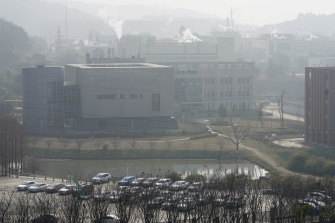https://www.smh.com.au/world/asia/sp...05-p58x89.html
Spending on PCR tests in China soared months before first COVID-19 cases revealed: report
 By Chris Zappone
By Chris Zappone
October 5, 2021 — 7.05am
Spending on tests used to detect coronavirus in China’s Hubei Province soared in the months before official reports of COVID-19 first emerged, suggesting the virus was spreading in the northern summer of 2019, well before it was publicly acknowledged by the Chinese government.
The data, compiled by Australian cyber security outfit Internet 2.0, showed that the sale of polymerase chain reaction tests – used to detect the presence of specific viruses – jumped to 67.4 million yuan ($14.3 million) in 2019, from 36.7 million yuan in 2018, and 29.1 million in 2017.

The Wuhan Institute of Virology in Wuhan, China.Credit:AP
“We have come to the conclusion that based on the data analysed it suggests the virus was highly likely to be spreading virulently in Wuhan, China as early as the summer of 2019 and definitely by the early autumn,” the report states.
The study, conducted by an open-source examination of contracts for PCR tests, also found “notable, significant and abnormal 2019 purchases of PCR equipment” in Wuhan by the People’s Liberation Army Airborne Army Hospital, The Wuhan Institute of Virology, the Wuhan University of Science and Technology and the Hubei Province Districts Centres for Disease Control and Prevention.
The Wuhan Municipal Health Commission reported the first cluster of cases on December 31, 2019. On January 5, the World Health Organisation published its first advisory on the cases. Experts from the group didn’t travel to Wuhan until January 20, as it consulted Beijing over the issue.
The murky timeline about the origins of the outbreak have fuelled intense international speculation over China’s handling of the pandemic.
Australia’s call for an inquiry into the origins of the pandemic drew a swift diplomatic rebuke from China, setting up the deterioration of relations between the two countries.
Based on the research, Internet 2.0 concluded with “high confidence that the pandemic began much earlier than China informed the WHO about COVID-19,” according to the report.
The revelations about the increase in PCR test purchases were first reported by
Sky News in September.
Internet 2.0, a cyber security firm that specialises in digital forensics and intelligence analysis, called for further investigation.
To confirm the hypothesis, Internet 2.0’s analysis compared the Hubei data to a data control sample drawn from across China, and found “the purchasing activity and trend in 2019 ... significant because it goes against trend in 2019 comparatively to the preceding years of 2007-2018”.
Several medical experts, however, said the Internet 2.0 report wasn’t enough information to draw such conclusions.
For one thing, PCR testing, which has been in broad use for several decades, has been growing in popularity as it has become a standard method to test for pathogens, according to one of the experts.
In addition, PCR equipment is widely used in laboratories to test for many other pathogens besides the virus that causes COVID-19, including in animals, and is commonly found in modern hospitals and labs.
China was also dealing with an outbreak of African swine fever across the country in 2019.
China’s Foreign Ministry disputed the findings.
A spokesperson said the findings fell into the same category as other dubious claims about the origins of the coronavirus, including a “so-called paper” that analysed traffic volumes near several hospitals in Wuhan and searched for the keywords “cough” and “diarrhoea” before concluding that the outbreak began in Wuhan as early as August 2019.
An Australian biochemist who has read the report and has requested anonymity because he wasn’t authorised to speak publicly on the matter, said more data was needed to explain the procurement numbers.
The biochemist, who has a strong background in PCR and research application and immunology, said the data spoke to a sudden, significant need for pathogen diagnostic equipment, but he said it only raised questions about what the equipment was being used to test.
David Robinson, Internet 2.0’s co-chief executive officer and the lead researcher on the paper, said in an interview that the timing of some of the contracts, and the agencies behind the purchases, lend credence to the idea that officials in Hubei province were investigating a new human disease throughout the latter half of 2019.
However, he said his firm’s findings weren’t a smoking gun.
“This data does not support any origins conclusions on COVID-19 but in the future some part of this data might support an origins finding,” according to a statement by Robinson and Robert Potter, the other co-CEO.
“Nor does this report identify a specific point in time where a pandemic emerged. The fact China has gone to great lengths to ensure conclusive evidence is unobtainable means unfortunately we may have to rely on third-party data points.”
